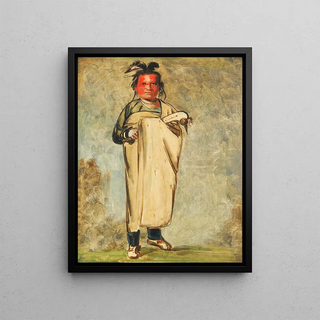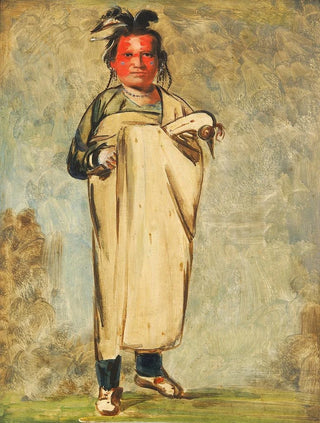Painting Kwkawnechoa un brave - George Catlin | Art print


View from behind

Frame (optional)
George Catlin’s painting "Kwkawnechoa un brave" is much more than a simple artwork. It serves as an open window into the history of Indigenous peoples of America, capturing not only the appearance of a warrior but also the very essence of their culture and identity. Created in the 19th century, this piece bears witness to the fascinating perspective Catlin had on Native tribes during a time when their way of life was undergoing profound change due to colonial expansion. The art print of this work allows viewers to immerse themselves in a universe rich in colors and meanings, while preserving the legacy of an artist who dedicated his life to documenting threatened cultures.
Style and uniqueness of the work
George Catlin’s style is distinguished by its striking realism, meticulous attention to detail, and ability to convey the emotions of his subjects. In "Kwkawnechoa un brave," viewers are immediately struck by the proud posture of the warrior, who seems to challenge the viewer’s gaze. The vibrant colors, ranging from earthy tones to brighter hues, evoke the richness of natural materials used by Native peoples. Catlin does not merely reproduce faces; he captures stories, traditions, and beliefs. Every element of the composition, from the costume to the accessories, is laden with symbolism and demonstrates ancestral craftsmanship. This painting, with its depth and complexity, invites reflection on the place of Indigenous peoples in American history and the challenges they have faced.
The artist and his influence
George Catlin, painter and ethnographer, is often regarded as one of the first artists to document Native cultures with such passion and precision. His journeys across the plains and Indian territories allowed him to meet diverse tribes, which he depicted with deep respect. Catlin understood that art could play a crucial role in preserving these threatened cultures. His work had a significant influence on subsequent generations of artists, inspiring a renewed appreciation for Indigenous traditions.

Matte finish

View from behind

Frame (optional)
George Catlin’s painting "Kwkawnechoa un brave" is much more than a simple artwork. It serves as an open window into the history of Indigenous peoples of America, capturing not only the appearance of a warrior but also the very essence of their culture and identity. Created in the 19th century, this piece bears witness to the fascinating perspective Catlin had on Native tribes during a time when their way of life was undergoing profound change due to colonial expansion. The art print of this work allows viewers to immerse themselves in a universe rich in colors and meanings, while preserving the legacy of an artist who dedicated his life to documenting threatened cultures.
Style and uniqueness of the work
George Catlin’s style is distinguished by its striking realism, meticulous attention to detail, and ability to convey the emotions of his subjects. In "Kwkawnechoa un brave," viewers are immediately struck by the proud posture of the warrior, who seems to challenge the viewer’s gaze. The vibrant colors, ranging from earthy tones to brighter hues, evoke the richness of natural materials used by Native peoples. Catlin does not merely reproduce faces; he captures stories, traditions, and beliefs. Every element of the composition, from the costume to the accessories, is laden with symbolism and demonstrates ancestral craftsmanship. This painting, with its depth and complexity, invites reflection on the place of Indigenous peoples in American history and the challenges they have faced.
The artist and his influence
George Catlin, painter and ethnographer, is often regarded as one of the first artists to document Native cultures with such passion and precision. His journeys across the plains and Indian territories allowed him to meet diverse tribes, which he depicted with deep respect. Catlin understood that art could play a crucial role in preserving these threatened cultures. His work had a significant influence on subsequent generations of artists, inspiring a renewed appreciation for Indigenous traditions.
12,34 €






